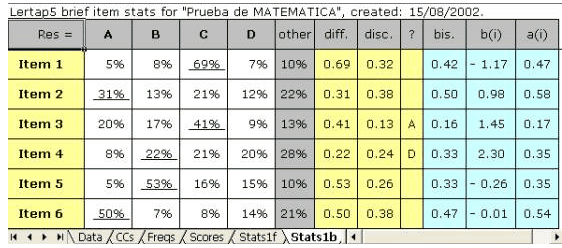IRT, item response theory
Historically, Lertap 5's main focus has related to the application of "CTT", classical test theory. But it certainly has support for IRT users, to be sure.
Those interested in the Rasch model will find support in Lertap5's RaschAnalyis1 routine. Other IRT models are supported via the EIRTanalysis1 Excel add-in. (Note: RaschAnalysis1 will work with both Windows and Macintosh computers, but EIRTanalysis1 may only be used with Windows.)
An option in the System worksheet to turn on "experimental features" will get Lertap 5 to add three columns to one of its standard reports, "Stats1b". These are the "bis.", "b(i)", and "a(i)" columns seen in the screen snapshot below:

a(i) and b(i) are estimates of the 2PL IRT parameters, while bis. is the biserial correlation coefficient. The derivation of these statistics is the focus of this paper.
Lertap 5 has extensive, well-developed support for users of ASC's Xcalibre IRT program, and it will also output data ready for input to Bilog-MG. (The data file made for use with Bilog-MG has a format also useful to quite a number of other programs, such as ConQuest and RUMM.)
A webpage which demonstrates the strong relationship between CTT and IRT statistics is available at this link, and a technical paper, somewhat critical of the Rasch model, may be found by following this hyperlink. Remember to take in this 2015 document when time permits, a document describing other historical IRT developments in Lertap 5.
